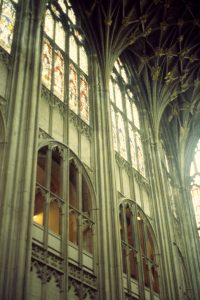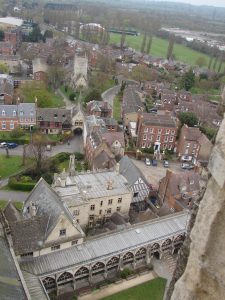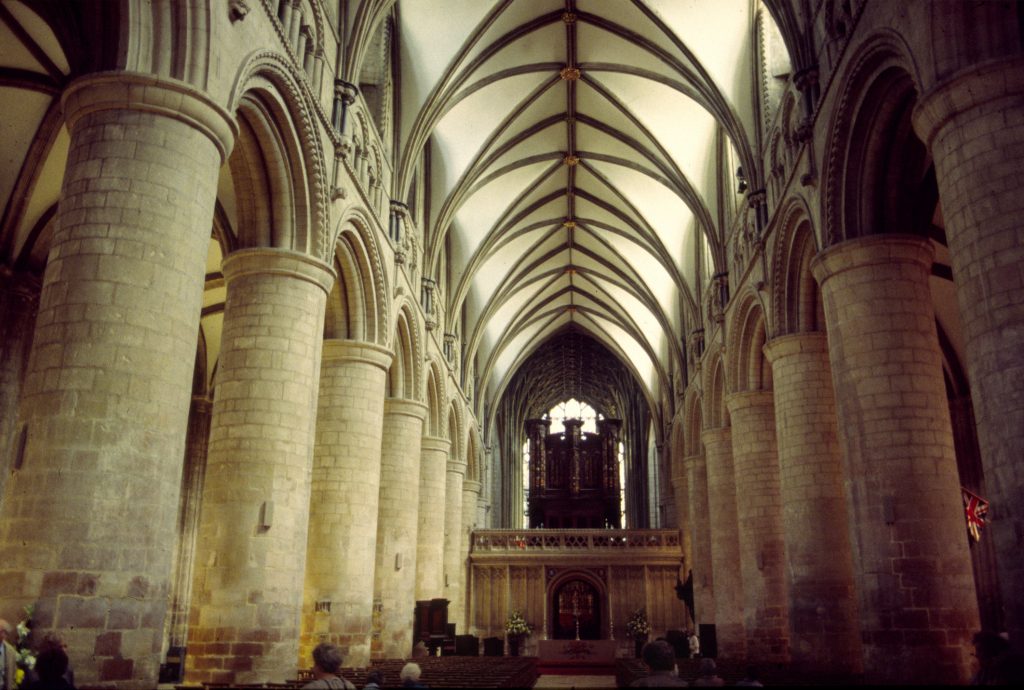My last blog post spoke of the history of Gloucester in the Roman and Saxon periods. Gloucester, another ancient city in England, is the West Country setting in 1392 for my third novel, Memento Mori, in the Lady Apollonia West Country Mysteries. I would like today to describe some surviving medieval buildings that appear in this novel, either in their full splendor or as ruins. The Abbey of Saint Peter will be my starting point.
 This medieval abbey survived the 16th century dissolution of the monasteries by becoming Gloucester Cathedral in the newly formed Diocese of Gloucester, carved out of the Diocese of Worcester, more than a century after Memento Mori is set. The church building, both inside and out, is much the same as it was in 1392. The nave, as shown in the first picture above, is a good example of Norman architecture while the Quire was remodeled in the 14th century to have a Gothic façade covering its Norman base, with a Gothic vault raised above the original Norman roof. This Gothic quire is shown above on the left.
This medieval abbey survived the 16th century dissolution of the monasteries by becoming Gloucester Cathedral in the newly formed Diocese of Gloucester, carved out of the Diocese of Worcester, more than a century after Memento Mori is set. The church building, both inside and out, is much the same as it was in 1392. The nave, as shown in the first picture above, is a good example of Norman architecture while the Quire was remodeled in the 14th century to have a Gothic façade covering its Norman base, with a Gothic vault raised above the original Norman roof. This Gothic quire is shown above on the left.
Lady Apollonia visited the the nave and quire of the abbey church in my story, to pay her respects to the tomb of King Edward II located between the ambulatory in the north quire aisle and the quire itself. Edward II had been killed earlier in the 14th century in Gloucestershire, but his tomb only found a home at the Abbey of Saint Peter after being rejected by Kingswood Abbey, an event mentioned in my first book, Effigy of the Cloven Hoof. King Edward III, the son of Edward II, bestowed generous gifts upon the Abbey of Saint Mary in Gloucester, not only to set up a regal memorial for his father but also to upgrade the entire quire area to its present Gothic splendor.
The great church where Apollonia visited King Edward II’s tomb was not the only building of the Abbey of Saint Peter to play a role in my story, however. Another was the abbot’s lodging which still stands next to the present cathedral church. It is shown just beyond the cloisters in the picture to the lower right, taken from atop the central tower. Near the top of the picture is Saint Mary’s Gate which was an important entry to the abbey in the 14th century.
 Stedmund Falford, one of the villains in my previous novel, Plague of a Green Man, appears again operating under a false identity in this story. Still he presents himself as a member of the noblility and seeks to be received as a guest of the abbot in these lodgings. Another surviving building of the abbey which was important was its infirmary. This is the site where Stedmund Falford, seeking sanctuary, comes to his worldly end after escaping his captors. Some of its ruins remain today and are shown in the picture at the end of this post.
Stedmund Falford, one of the villains in my previous novel, Plague of a Green Man, appears again operating under a false identity in this story. Still he presents himself as a member of the noblility and seeks to be received as a guest of the abbot in these lodgings. Another surviving building of the abbey which was important was its infirmary. This is the site where Stedmund Falford, seeking sanctuary, comes to his worldly end after escaping his captors. Some of its ruins remain today and are shown in the picture at the end of this post.
In my next posting, we will return to medieval Gloucester to show more ancient buildings that appear in the story of Memento Mori.

